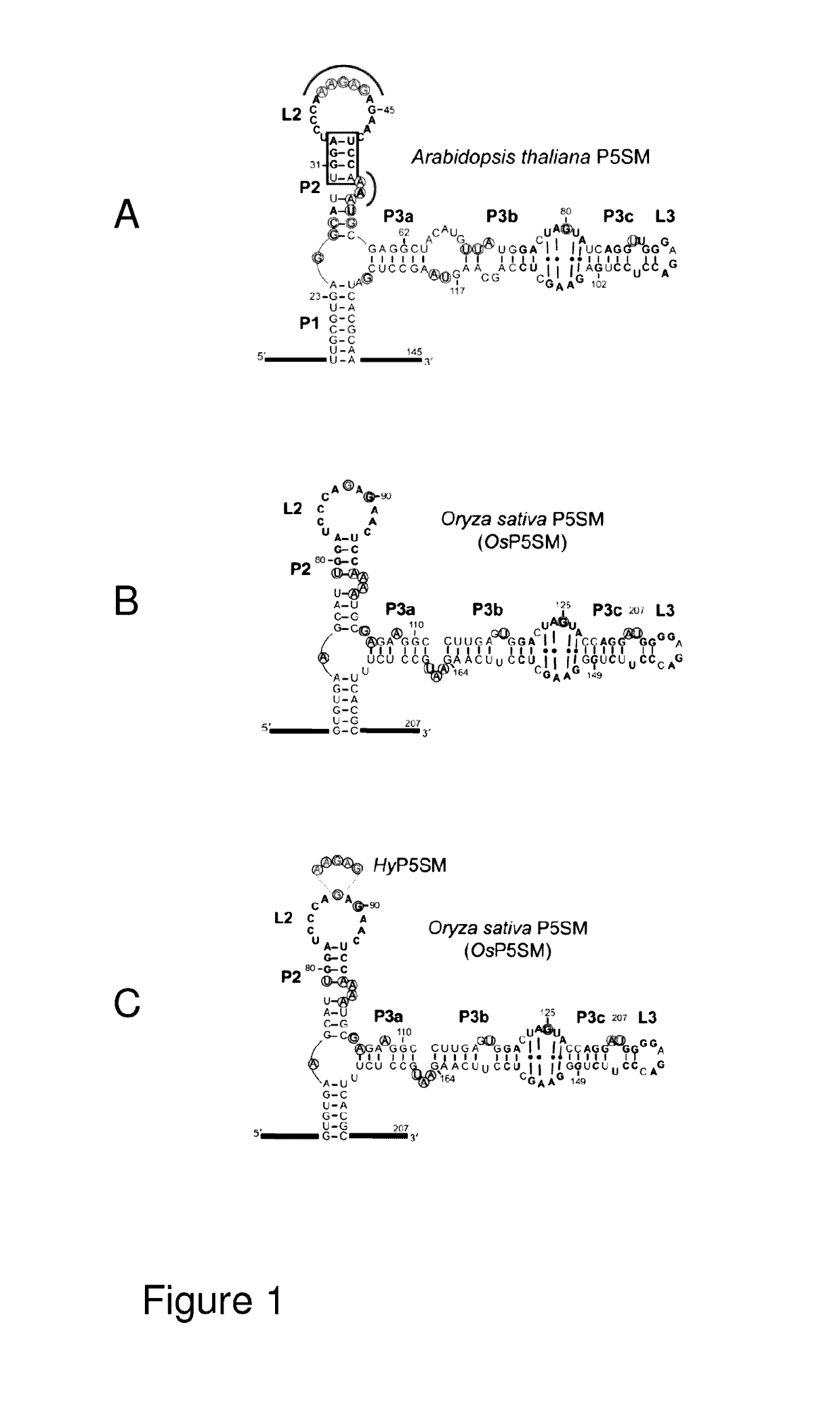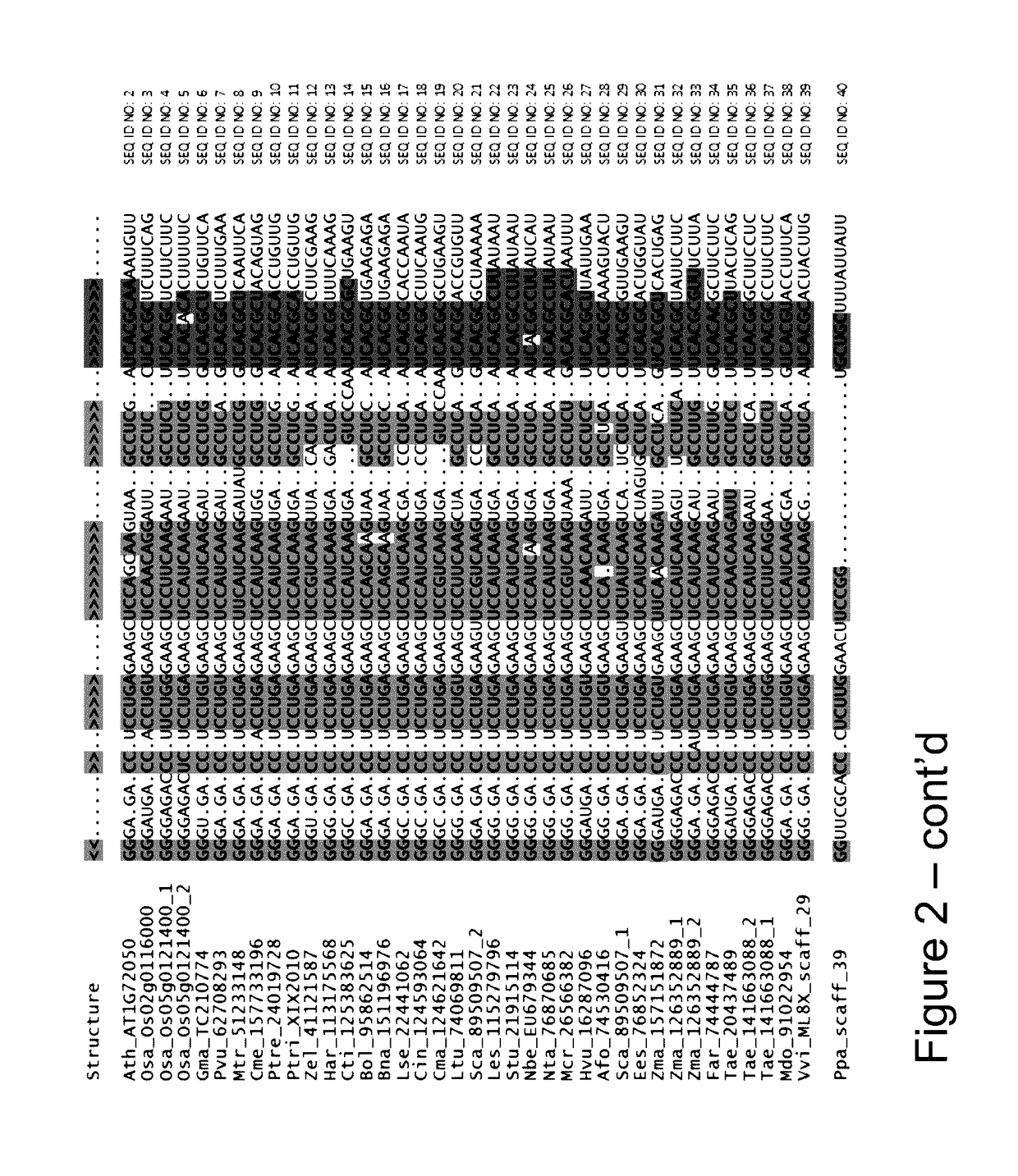P5SM suicide exon for regulating gene expression
a technology of p5sm and exon, which is applied in the field of inducible hybrid plant 5s rrna mimic (p5sm) rna elements, can solve the problems of pleiotropic effects, many conditional promoter issues, and difficult serial synthesis of promoters, so as to maintain splicing fidelity and robust gene activation
- Summary
- Abstract
- Description
- Claims
- Application Information
AI Technical Summary
Benefits of technology
Problems solved by technology
Method used
Image
Examples
example 1
[0146]The following Example relates to the characterization of a natural splicing cassette containing a plant 5S rRNA mimic (P5SM) suicide exon, and an engineered splicing cassette containing a hybrid P5SM (HyP5SM) suicide exon as regulators of gene expression.
Materials and Methods
[0147]Oligonucleotides and DNA Constructs
[0148]Sequences of all synthetic primers used for making and mutagenizing DNA constructs, performing overlap extension PCR, RT-PCR, and RT-qPCR are described in Table 1. TFIIIA-eGFP (formerly called Pre-EGFP), LUC (used as a control except when assaying the fLUC reporter), AtL5, and DsRed2 constructs were described previously (23). The coding sequence of OsL5 (Os01g0896800) also was previously isolated and cloned into the pBinAR vector (23). The fLUC coding sequence was derived from the pGL3 vector (Promega). Arabidopsis thaliana coding sequences were amplified by PCR from cDNA (see RNA isolation methods) and cloned using the TOPO TA Cloning kit (Invitrogen). Mutati...
example 2
[0192]The following Example relates to the generation and characterization of a chemical-inducible P5SM suicide exon cassette that can activate or inhibit expression of a transgene.
Chemically Activatable Splicing Cassette
[0193]We have shown that mutations to the P2 stem (M4 / M5) of HyP5SM eliminate binding to the L5 ribosomal protein and lead to constitutive exon retention within a transgene, i.e., default gene expression is off (FIG. 14). In these mutations by default, the proximal splice sites are used, thus the P5SM element is retained. We will introduce a nucleotide aptamer sequence to overlap the proximal 5′ splice site or the proximal 3′ splice site (FIG. 13A), so that the addition of a chemical inducer, such as theophylline or tetracycline, will sequester the proximal slice sites. Sequestration of the proximal splice sites will lead to P5SM exon skipping and consequently activate transgene expression, as binding of the chemical inducer to the aptamer forces splicing at the dis...
example 3
[0196]The following Example relates to the use of the engineered HyP5SM suicide exon cassette to regulate expression of the pathogen effector protein AvrBs2.
Introduction
[0197]Effector-triggered immunity (ETI) is a plant innate immune pathway that is activated when plants that possess disease resistance (R) genes recognize specific pathogen effector proteins. The ETI response includes a defensive “hypersensitive response” (HR) that involves localized cell death at the site of pathogen recognition, thereby quarantining the pathogen. Although many R protein and effector protein pairs are known to trigger HR when co-expressed, the immediate and far downstream signaling events remain unclear. Generating transgenic plants that inducibly express effector proteins is problematic due to the very sensitive HR phenotype triggered by low levels of the effector protein.
[0198]AvrBs2 is a conserved bacterial effector protein from Xanthomonas euvesicatoria, the agent responsible for black spot dise...
PUM
| Property | Measurement | Unit |
|---|---|---|
| chemical | aaaaa | aaaaa |
| size | aaaaa | aaaaa |
| temperature | aaaaa | aaaaa |
Abstract
Description
Claims
Application Information
 Login to View More
Login to View More - R&D
- Intellectual Property
- Life Sciences
- Materials
- Tech Scout
- Unparalleled Data Quality
- Higher Quality Content
- 60% Fewer Hallucinations
Browse by: Latest US Patents, China's latest patents, Technical Efficacy Thesaurus, Application Domain, Technology Topic, Popular Technical Reports.
© 2025 PatSnap. All rights reserved.Legal|Privacy policy|Modern Slavery Act Transparency Statement|Sitemap|About US| Contact US: help@patsnap.com



